February. Linn Kastan creates the first pair of tubular BMX forks in the workshop of his company REDLINE, a speedway motorcycle frame builder. Fork wise, Red Line was it. Nothing else would do. The buyer even had the option to buy the chrome-moly nickel plated fork or the cheaper priced mild-steel painted one (1975). Either one would do -as long as it said Red Line up the sides.
Linn Kastan, www.vintagebmx.com: We didn't stop making those things for about six years. They were known as "chromoly forks" and that's all anybody called them in those days, was "Redline forks" or "Redline chromoly forks."
Heavy, bladed Ashtabula forks would soon become a thing of the past.
November. Redline begins the very first production of BMX frames; known as the ‘75 Squareback -- due to it’s angled rear stays. The front end was very short and featured a small wedge gussett.
Linn Kastan, www.vintagebmx.com: That Squareback design was just the way that I thought we should do it. We were in the motorcycle business, and that’s the way motorcycles were made. The first ones had a small single gusset right in the middle. The next version had a larger gusset with two holes in it. From november 1974 to march 1978 we made 10,500 frames.
December. Christmas sales of the first Redline’s didn’t go too well, as not many shops could not sell an $85 frame. Unheard of price at the time.
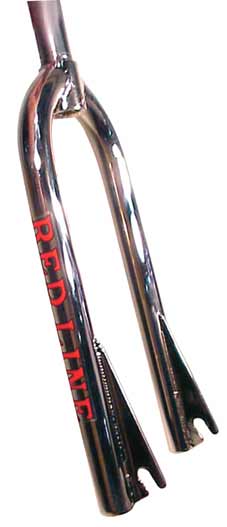
April. Article on Redline in Motorcycle Industry News paper. Quote: We feel right now that (BMX) is on the verge of exploding. The bicycle thing could take off.
May. First cover of Bicycle Motocross News with a Redline Fork on a bike; John George.
June. Redline’s very first front-cover: Bicycle Motocross News, with John Palfreyman at Saddleback, aboard a 3-of-a-kind looptail Redline prototype. Many more covers to come!
September. Not everyone could afford the "expensive" $30 chromoly Redline fork. Thus, Redline introduces a $15 version of it, made of steel and powder coated black.
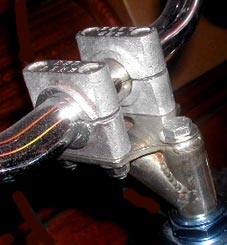
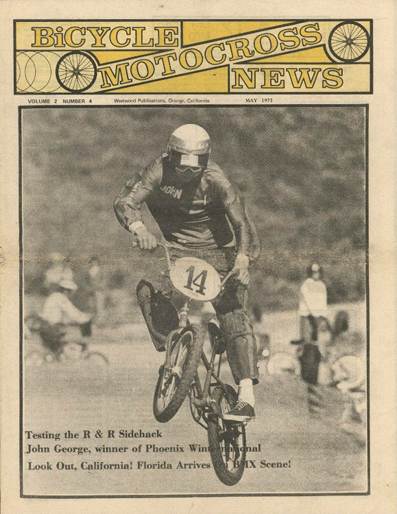
Bicycle Motocross News may 1975.

Bicycle Motocross News june 1975.
July. The who's who of BMX is running Redline forks by now. Fork sales skyrocket, and cheap imitators are in the wings.
March. Redline's first Proline is created; utilizing a 5 inch headtube and thin rear dropouts. Byron Friday races it down one of the gnariest downhills in BMX history; Weinart Mountain. It survives.
Bill Curtin, www.vintagebmx.com: The "Pro Line" came out in 1977. It consisted of a doubleclamp stem, V bars and a frameset. The original Pro Line products were nickel plated. The bars were not knurled and the bend was different (The V cross bar had a deeper bend) than the later Japanese manufactured stamp/knurled bars. The double clamp stem was always nickel plated and was later replaced by the Suntour built "Brute" stem.
Linn Kastan buys Mike Konleout of Redline.
The first Proline was made in march of 1978.
In '78, you were definitely a nobody unless you had a pair of Red Line V bars clamped to your stem. Your stem was probably an Ashtabula (if you were short on cash), or a Mongoose or Cook Bros. (if you were rich). Still, no matter what your cash flow was, Red Line V's were HOT items.
Linn Kastan, www.vintagebmx.com: The problem with the handle bars were was that the kids would break them off right where the crossbar welded. I put the bend in them so that they had a bit of spring to them; it put a little flex in the bar because with a straight crossbar. It had no flex in it at all. With a bent one, it was like a spring.
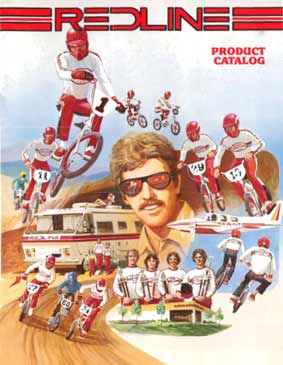
1978 catalog.
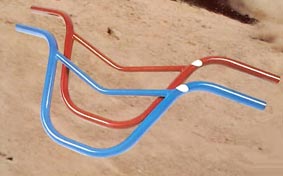
Linn Kastan, www.vintagebmx.com: I went to Japan in april of 1979 and stayed over there two months in Kobi, Japan, and trained six kids that worked for Kalamura, how to tig weld. There weren't any machines over there. I had to bring them all from here and there was a little room in their office building where it was the only place where anyone spoke any English at all. They had two factories but nobody spoke English there. So we moved these, I think there were six welding machines, into this little room that was no bigger than a double car garage, and that's where all the Redline production was done for quite a few years after that.
Stuffed inside the Red Line motorhome during that summer were Dave Clinton, Jeff Ruminer, Bob Hadley, Dennis Dam, and Greg Hill. AWESOME. You probably could guess that Red Line RULED BMX racing this year.
November. Stu Thomsen becomes ABA’s very first No.1 Pro; wrapping up the title at the Grands in Las Vegas. he is quickly signed to BMX's first major Pro contract; with REDLINE!
Linn Kastan, www.vintagebmx.com: I started on the flight cranks around late 1976, and there was a bunch of generations that I started from the beginning. Late 1977, I think it was that I went to Japan as a guest of Shimano, I got real excited about doing things over there instead of making frames and forks over here and then importing 35 parts to make a bicycle. I got the idea that what I'd like to do was make some kind of a deal with a small factory over there. Teach them how to make frames and forks for me, and let them assemble complete bicycles for me. So, when I got back from there, my partner and I disagreed on that so I bought him out of Redline in 1978, and I was working on those cranks for about a year and a half before that and he had such little faith in that particular product that he let me have that for free, I didn't have to buy that from him. It turned out to be our best product ever, actually. I went through half a dozen generations of them. The first one lasted about a half an hour. It was very difficult to come up with what I wanted to come up with because the existing parts that we had to utilize. The spindle sizes because of the bearings and all that stuff, were so small that I really couldn't put much of any size in there. There were a bunch of prototypes; I think we made a couple of hundred that we used for testing and on the tours, and just to kind of find out what we were doing; and I really didn't get into it until I found somebody that could make that proper tubing the way I wanted it; and then that's what launched us.
By 1980, Flight cranks were pretty much the only domestic product.
February. Mighty Stu gets handed the keys to a customized Van; his prize from ABA for being No.1 Pro.
July. John Crews pictured on cover of BMXA.
December. Stu Thomsen’s first BMXA cover.
Stu Thomsen graces the covers of every major BMX magazine. He's everywhere you look. To quote the magazine editors at the time: "Stu is The Man."
July and august. Redline joins together with the ABA to put on the massive Redline Summer Tour. Custom belt buckles to all the winners!
November. Jeff Kosmala photo shoot with BAD
Linn Kastan, www.vintagebmx.com: RL and his father approached me. They were trying to say that freestyle was a market waiting for a product. It was sort of the opposite. He just claimed that if somebody would start supplying these things that they would be an instant success. And he wasn't right about the instant success, but in the end, he was right. Actually, as I recall RL and Buff were riding for the magazine, and I think Bob started getting some heat about that from advertisers because people were advertising their product in his magazine, and he was advertising his own team, and I think people thought it was too much of an inside job, so RL came to me and said, "I’d like to get away if you can handle this," and I said, "all right, I'll take it over then." We got into it about 1983, so I don't think we worked together over 3 years.
January. Redline introduces the Forklifter system; still one of the cleanest and most precision chromoly handlebars ever created. The 4-piece bar featured capped/curved ends and welded-on numberplate tabs, to fit the pre-formed Forllifter plate.
September. Redline’s rookie; D.D. Leone wins the NBL Grands in B-Pro.
October. Yet another Redline first: Tappered tubing (large to small diameter) on their forks.
December. Redline introduces their first ATB’s, with odd raised rear chainstays. The first Conquest is born.
February. Past No.1 Pro in the NBA - Scott Clark, hired as Redline’s top pro.
September. Steve Giberson, ex-editor of BMX Action magazine, hired by Redline as Team Manager.
Steve Giberson: My most memorable Redline moment would be the time I told Scott Clark he had to drive the Redline motorhome to Canada for the filming of RAD, the movie.
Billy Griggs: I signed on in October of 85', turned pro in Feb. 87', then left in Dec. 90'
December. The 1986 line of Redline’s arrive, in a trend setting variety of colors ranging from turqoise to to red to hazard yellow to "radberry" (a sort of purple).
January. Billy Griggs named as part of BMXA’s Terrible Ten.
February. Billy Griggs on cover of BMX Action.
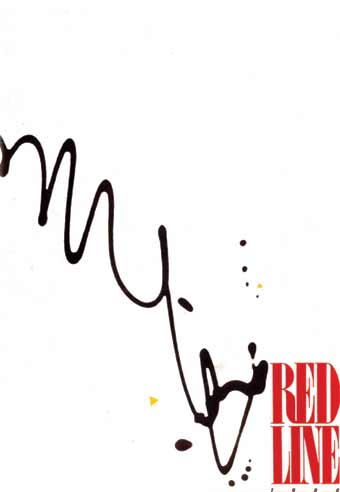
Matt Ludwig, june 2009: You write that the Conquest name first used in 1990. I own a 1986 Redline Conquest mountain bike. It was all Suntour XC with XC Roller Cam brakes.
February. Billy Griggs kicks it out on front cover of the legendary GO magazine.

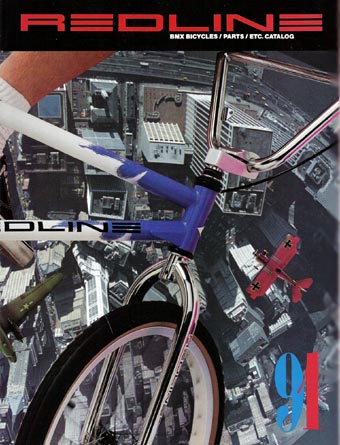

June. Green is replaced by Wade Bootes as the Redline Pro.
September. For the third time in his life, Greg Hill joins up with Redline and together, Greg Hill Speed Seminars begin.
December. Matt Hadan comes on board as Redline’s other AA-pro for ‘96.
May. With the departure of Bootes and Hadan to a frame company with no seatpost, Greg Hill and Redline negotiate to sign on John Purse; mid-season. He immediately begins flying on his alloy Proline.
October. Redline debuts their customized Boxtruck at the ABA Fallnationals. It features big roll-up doors on the side, displaying Redline gear in the windows. Immediately, it heads out on the road, being driven by Greg Hill to each Speed Seminar and BMX national.
Ride BMX UK october 1996: REDLINE have new bikes for 1997. The most outstanding model is an all new dirt jumping bike, which features a trimoly frameset, 48 spoke wheels, cromo forks, Aheadset, 6mm thick dropouts, dirt tyres, and a price tag of probably less than £300. We checked it out.
January. Redline Team Manager Greg Hill starts the year off with an impressive Amateur squad - Eric Kleist, Chris Powell, Mikey Hanner and Corky Gainsford.
February. Redline brings back the Conquest name as thier first entry in to Cyclocross racing; introducing a super lightweight Scandium tubed frameset.
May. Redline re-invents the Flight crank; adding a 2nd pinch bolt, beefing up the spindle, and painting them red.
October. Redline’s first cyclocross team kicks off what becomes a long standing tradition of winning.
November. Redline debuts their proto-type triple-clamp forks, and starts a whole-new revolution and controversy.
By the end of Thanksgiving weekend, John Purse has added a Golden Crank Award and ABA No.1 Pro plate to his resume.
February. The famous Forklifter bars re-designed; now alloy with oversized tubing.
April. The triple-clamp Flight Fork swings in to production. The reaction is mixed; dividing the race scene in half.
May. Redline nabs Utah local Matt Berringer as their first factory sponsored dirt jumper.
July. Prototype testing begins on Redline’s first monocoque frame design. The public gets it’s first sneak peak at a national in Idaho.
September. Redline premieres their ‘99 line -- which for the first time ever, includes a dirt-thrashin’ "X-Series" line of heavy duty bikes: Triple-X and Double-X.
October. John Purse cover on BMXer mag.
November. Redline pro John Purse winds up the year as the most winniest Pro in the history of BMX - scoring a unbelieveable 25 wins in one season.
December. Greg Hill parts ways with Redline.
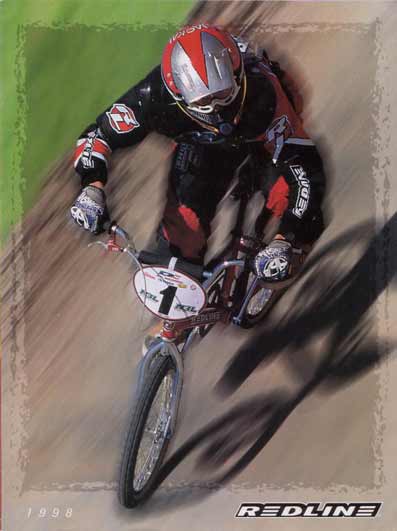
1998 catalog.
September. Interbike Show: Redline debuts the 2000 line, starring a chromoly "Signature Series" line of bikes, as well as the "Dually" -- a dual slalom specific machine.
Seattle Bike Supply, official distributor of Redline and Torker Bicycles, is pleased to announce the addition of gOrk to their 2000 line-up. But don't look for gOrk to be sold in any of SBS's 3,000 independant bike dealers. As of October 1st, gOrk will be the latest addition to the phone-friendly SBS staff, in the position of Marketing & Promotions Director.
gOrk, www.bmxextreme.com, august 1999: That's right, I am leaving ABA. Right after the Gold Cup Finals West, I will pack up the U-Haul and make the big move to the completely opposite climate of Seattle, WA. After ten years (almost to the exact day), I accepted an awesome job working for SBS; who owns and distributes Redline and Torker bicycles. In this position, I will be in charge of putting out their monthly 40-page flyer (which goes to all dealers), as well as directing their ad campaign, sponsorship and team. Needless to say... I am STOKED. I've got that "new job" psych and this position will be a great challenge. The October '99 issue of the BMXer will be my last mag, and Reno's Black Jack Nationals (this weekend) will be the last race I cover for the ABA.
November. Redline signs up 14 year old Amateur sensation Bubba Harris to the team, for 2000.
December. Redline buys Huffy's 40 foot long trailer and a new dually; for their new Team vehicle. Plans to completely take over the BMX Racing World go in to effect.
February. Torker Pro Jason Carne$ is hired to drive the new Redline rig. He’s handed the keys to a new Ford F-350 Dually, a Rand McNally map, a unlimited SBs gas card, a Proline bike and a Redline uniform.
March. The Factory Squad Support vehicle makes its debut in Phoenix. Also joining the team that weekend is Indiana dirt jumper Adam Strieby.
September. Team Redline is joined by super fast girl racer Kim Hayashi.
November. Redline prez Chuck Hooper is inducted in to the BMX Hall of Fame, and Kim Hayashi earns her first ABA Natl. No.1title.
John Purse ends deal with Redline.
Press release, may 2001: AA Pro John Purse, one of BMX racing's biggest stars, has ended his contract with Redline. Redline exercised a clause in its contract that allowed it to release riders if an injury kept a rider from competing for more than three months. Purse declined an offer from Redline that would pay him based on his performance. Purse has been injured and unable to race since January. "Purse was a great representative for Redline, one of the best racers around, and he did a lot for us," said Craig Barette, Redline's marketing manager. "But Matt Hayden is now our number one guy, and we want to put all our faith and support in him and see what he does with it," Barette said. Purse had ridden for Redline since 1994.
June. A kooky Australian named Kamakazi arrives for the summer; and wins a AA-pro main within his first month in the States. A new Foreigner record.
November. Hayashi repeats her No.1 title. Immediately following the Grands main events, Kim Hayashi and Bubba Harris sign Pro applications.
March. Bubba Harris makes his first Pro podium ... with plenty more to come.
September. Redline puts on the first ever Redline Cup of Cyclo-cross; a 3-race series in Washington, Utah and California.
November. After leading the points chase all year long, Jason Carnes wins the ABA No.1 Vet Pro title.
April. BMXer cover: Jason Carne
October. Redline debuts their limited edition, 100 of a kind, 30-year Aniversary frame kit (complete with nickel-plated V-bars and Flight cranks) at Interbike.
Gork, Transworld BMX november 2003: Back in 1992, SBS/Redline celebrated their 20th anniversary with a limited-edition frame called the Platinum. I remember wondering why they chose 1972 as the founding date of Redline. For decades, it had been written that February 1974 was when Linn Kastan made the first tubular chromoly fork, which changed BMX forever. Once I became marketing director here, I wanted to set the record straight and really go all-out with the 30-year anniversary. The first obstacle was nickel plating. Not many people do nickel nowadays, especially in China. Then there were the details for fitting in the '76 Squareback gusset, which was solved by adding the traditional five-inch headtube, which first appeared on Pralines in 1979, The frame design is based on the same geometry of our chromoly Signature Pro frame. We sent them a fully restored '75 Squareback to replicate all of the Redline trademarks; from precise small weld beads, all the way down to the way they used to weld the two-hole gussett on. They did a great job matching everything, even down to the coaster-brake bracket, which is where the laser-etched numbering will be.
November. Team Redline shows up at the ABA Grands in their brand new Retro uniforms. Jaws drop.
February. Redline’s Official 30 year Anniversary date.
Mike, www.ridebmx.com, february 2005: I asked Redline if they would be into redoing the whole freestyle program... They asked me what I would need and what I would change, so I e-mailed them a list of stuff that I thought they would say was not possible, but they basically said "sure, here's our budget, and here's what we can do..."
I guess my role is kind of Team Manager, and I'm going to pretty much reconstruct the entire Redline freestyle program. It's going to take a little bit, but over the course of the year, there's going to be a new ad concept, new bikes, and new web site. They didn't really have any thought of a team. I told them that the only way that I could really do it was if we picked a whole new team and started from scratch. I wanted to pick guys who I thought deserved more and hadn't really had a chance to get out there yet. Dustin Guenther is a Canadian rider from Vancouver and I knew he hadn't been given the opportunity to go to a lot of stuff. Rich Hirsch is a super-awesome rider. He's a real street guy, plus he's helping out with a lot of other stuff. I just wanted a well-rounded team. We all signed a two-year deal, and hopefully, by the end of the summer, everyone will be able to see some drastic changes and get a feel for the new Redline, because that's what it is. The way big companies work, I guess, is that making bikes takes 14 months. The new bikes have already been ordered, and we're going to begin work on the bikes that will come out as soon as possible. A lot of these bikes are all made at the same factories as a lot of the other companies, so they'll be bikes that are good quality and good design, and cheaper than most. I think it will be rad for kids who want to get into it and want to have a cool bike.
Redline Finds A New Home In The UK.
Press Release, october 19, 2005: It is with great pleasure that I announce that Padded Cell Supplies Ltd. are now the new exclusive UK distributors of Redline BMX bikes. Redline is a brand with its roots firmly intertwined with those of BMX itself and Padded Cell prides itself on it's commitment to and passion for BMX in all its forms. Redline has been largely missing from the UK market for a couple of years, but after talks at Interbike this year the deal was struck between Seattle Bike Supply and Padded Cell which will see the newly improved and revamped Redline bike range reintroduced to this country. Redline have recently taken on a trio of riders, Mike Escamilla, Dustin Guenther and Rich Hirsch who have worked hard at improving and updating the bikes so that the entire range shows the quality of construction and design that Redline BMX race bikes have long been known for. We expect the first shipment of bikes to arrive in Great Britain about mid March, with high-end frames arriving well prior to that. Redline sponsored UK BMX race and freestyle riders will be announced in plenty of time for the bikes to arrive with dealer price lists and catalogues planned to be in the shops before Christmas.
James Ayres, www.ridebmx.com, february 2006: Redline's high-end Device line consists of a frame, forks, these bars, and probably a few other parts we're missing. One thing we do know is that if it carries the Device name, it's dialed. Since Mike Escamilla, Dustin Guenther, and Rich Hirsch came on board, Redline's freestyle line has never looked better.
Device Bars: 100% heat-treated and butted; tubing thickness varies between 1.0 to 1.6mm so that it's thicker at the welds, clamp area, and bends while reducing weight everywhere else. Weight: 23.6 oz. 12-degree back sweep; 4-degree upsweep; 7.25" rise, 25" wide. Suggested retail: $54.99.
Accell Group completes acquisition of Seattle Bike Supply
Press release, march 2006: Accell Group N.V. has completed the acquisition of all outstanding shares in Seattle Bike Supply Inc. (SBS; Seattle, USA). The acquisition was announced at the beginning of February. The transaction is financed from Accell Group’s own resources. SBS is expected to contribute to the earnings per share of Accell Group in 2006. Consolidation will take place as of 1 March 2006.
Bart de Jong, www.fatbmx.com, march 2006: gOrk and his posse of riders including Redline's Rooftop, Dustin Gunther, Tyrone Williams and Bubba Harris are now working/riding for a Dutch firm called Accell Group. We're pretty sure it will be business as usual over there at SBS but the company got bought by the Accell Group at the beginning of this month. Accell will use this position to sell Redline bikes through their giant network in Europe.
Mike "Rooftop" Escamilla, www.ridebmx.com, february 2, 2007: The designers, art guys and Chuck have been awesome to work with. Unfortunately gOrk's plans for Redline aren't the same as mine. Hopefully it doesn’t affect the rest of the team.
gOrk, www.ridebmx.com, february 2, 2007: We are really thankful for his two years of service to Redline and helping us be become a more 'legit' brand of bike. I could go on forever about all the good stuff he did for us. However, his contract was up at then end of 2006 and we had been going back and forth on some things. His direction didn't exactly mesh with where we want to take the direction of the brand.
Tim "Fuzzy" Hall joins Redline.
www.vitalbmx.com, february 2007: The most legendary BMXer from Utah has signed the dotted line with Redline, filling the team Manager/Rider position on their freestyle program. Fuzzy has big things planned for Redline in 2007; including a tour, a flow team and a factory squad with the potential to place on the podium at all the big comps.
Matt Beringer 1998 - january 2000
Jason Brown january 1999 -january 2000
Mike Escamilla 2005
Dustin Guenther 2005
Rich Hirsch 2005
Pat Miller january 2000 - ....
Adam Strieby january 2000 - Transworld BMX february 2004: Redline has announced that they won't be renewing Adam Strieby's contract for next year.